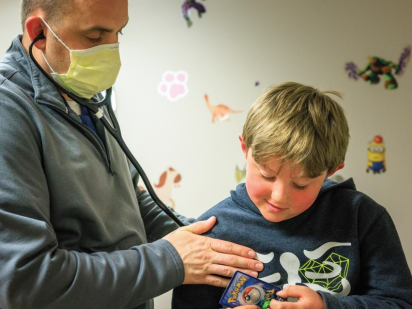As a parent, I’ve often wished my children came with instruction manuals. These detailed manuals would include information such as: “This child will eat these foods, is allergic to this, will break their arm at age five, doesn’t like this or that.” While these manuals unfortunately don’t exist, I’ve come to learn my children’s pediatrician is my best resource.
Because childhood is a time of rapid growth and change, it’s important to have your child seen by a pediatrician on a regular basis, even when they’re healthy. Well child visits are a time when parents can check up on their child’s health and make sure they’re growing and developing normally. Well child visits usually start a few days after children are born and should continue until they turn 18.
Prevention
Keeping up with immunizations is key to preventing illness. At each well child visit, the provider will ensure your child is current on their shots.
The visit also is an opportunity for your child’s provider to identify health problems, especially those that are easy to miss. “Parents, of course, know their child more than anyone, but they probably don’t have the medical expertise that we [pediatricians] do. We watch and monitor for things that are abnormal before they become a problem,” said Joseph Stonehocker, CPNP-PC, who specializes in pediatrics at Trinity Health Western Dakota.
Even if your child receives a clean bill of health, talking about ways to improve care and prevent problems helps keep them healthy. “We’ll teach them about caring for their body, healthy eating and sleeping and good decision making.”
Tracking Growth and Development
A well child visit will allow you to see how much your child has grown since their last checkup. The visit includes a complete physical exam where the provider will record your child’s height, weight, head circumference and other information in their medical record and assess their developmental milestones and social behaviors.
“I evaluate a lot of things just by observation. I can pick up things in the sensory realm, the respiratory realm and even the cardiac realm by looking at the child and how their body is presenting itself,” said Stonehocker.
Raising Concerns
A well child visit is an opportune time to bring up your concerns regarding your child’s health and behavior. To get the most out of your visit, prepare by making a list of questions and concerns you want to discuss with the provider.
“We are approachable. Ask us questions. Ask the whys, ask the how comes,” said Stonehocker. “When you leave our office, we want you to feel comfortable with the visit and confident that you can care for your child.”
Team Approach
Regular visits to the pediatrician create strong, trustworthy relationships among the provider, parent and child. When your child comes for a well child visit, the provider gets to know your child better and can provide more efficient care.
“My job is not to tell you what to do or how to raise your child. I’m here to walk the parenting path with you, from the birth of your child until they are 18 years old,” he added.
Schedule of Well Child Visits
The American Academy of Pediatrics suggests a well child visit at each of these ages: 2 to 5 days, 1 month, 2 months, 4 months, 6 months, 9 months, 12 months, 15 months, 18 months, 2 years, 2 1⁄2 years, 3 years, and each year after that into adulthood.
Most well child visits are no or low cost to you if you have health insurance.
Stonehocker practices at Trinity Health Western Dakota in Williston. To make an appointment, call 701-572-7711. To make an appointment with a pediatrician in Minot, call 701-857-5413.

